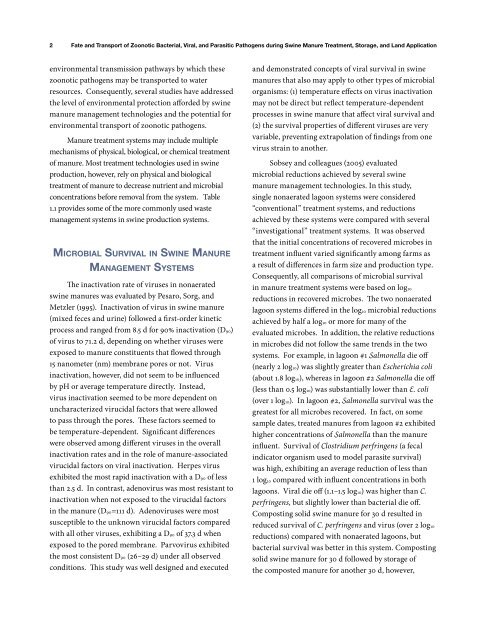Fate and Transport of Zoonotic Bacterial, Viral, and - The Pork Store ...
Fate and Transport of Zoonotic Bacterial, Viral, and - The Pork Store ...
Fate and Transport of Zoonotic Bacterial, Viral, and - The Pork Store ...
You also want an ePaper? Increase the reach of your titles
YUMPU automatically turns print PDFs into web optimized ePapers that Google loves.
2<br />
<strong>Fate</strong> <strong>and</strong> <strong>Transport</strong> <strong>of</strong> <strong>Zoonotic</strong> <strong>Bacterial</strong>, <strong>Viral</strong>, <strong>and</strong> Parasitic Pathogens during Swine Manure Treatment, Storage, <strong>and</strong> L<strong>and</strong> Application<br />
environmental transmission pathways by which these<br />
zoonotic pathogens may be transported to water<br />
resources. Consequently, several studies have addressed<br />
the level <strong>of</strong> environmental protection afforded by swine<br />
manure management technologies <strong>and</strong> the potential for<br />
environmental transport <strong>of</strong> zoonotic pathogens.<br />
Manure treatment systems may include multiple<br />
mechanisms <strong>of</strong> physical, biological, or chemical treatment<br />
<strong>of</strong> manure. Most treatment technologies used in swine<br />
production, however, rely on physical <strong>and</strong> biological<br />
treatment <strong>of</strong> manure to decrease nutrient <strong>and</strong> microbial<br />
concentrations before removal from the system. Table<br />
1.1 provides some <strong>of</strong> the more commonly used waste<br />
management systems in swine production systems.<br />
Mi c r o b i a l Su r v i va l in Sw i n e Ma n u r e<br />
Ma n a g e M e n t Sy S t e M S<br />
<strong>The</strong> inactivation rate <strong>of</strong> viruses in nonaerated<br />
swine manures was evaluated by Pesaro, Sorg, <strong>and</strong><br />
Metzler (1995). Inactivation <strong>of</strong> virus in swine manure<br />
(mixed feces <strong>and</strong> urine) followed a first-order kinetic<br />
process <strong>and</strong> ranged from 8.5 d for 90% inactivation (D90)<br />
<strong>of</strong> virus to 71.2 d, depending on whether viruses were<br />
exposed to manure constituents that flowed through<br />
15 nanometer (nm) membrane pores or not. Virus<br />
inactivation, however, did not seem to be influenced<br />
by pH or average temperature directly. Instead,<br />
virus inactivation seemed to be more dependent on<br />
uncharacterized virucidal factors that were allowed<br />
to pass through the pores. <strong>The</strong>se factors seemed to<br />
be temperature-dependent. Significant differences<br />
were observed among different viruses in the overall<br />
inactivation rates <strong>and</strong> in the role <strong>of</strong> manure-associated<br />
virucidal factors on viral inactivation. Herpes virus<br />
exhibited the most rapid inactivation with a D90 <strong>of</strong> less<br />
than 2.5 d. In contrast, adenovirus was most resistant to<br />
inactivation when not exposed to the virucidal factors<br />
in the manure (D90=111 d). Adenoviruses were most<br />
susceptible to the unknown virucidal factors compared<br />
with all other viruses, exhibiting a D90 <strong>of</strong> 37.3 d when<br />
exposed to the pored membrane. Parvovirus exhibited<br />
the most consistent D90 (26–29 d) under all observed<br />
conditions. This study was well designed <strong>and</strong> executed<br />
<strong>and</strong> demonstrated concepts <strong>of</strong> viral survival in swine<br />
manures that also may apply to other types <strong>of</strong> microbial<br />
organisms: (1) temperature effects on virus inactivation<br />
may not be direct but reflect temperature-dependent<br />
processes in swine manure that affect viral survival <strong>and</strong><br />
(2) the survival properties <strong>of</strong> different viruses are very<br />
variable, preventing extrapolation <strong>of</strong> findings from one<br />
virus strain to another.<br />
Sobsey <strong>and</strong> colleagues (2005) evaluated<br />
microbial reductions achieved by several swine<br />
manure management technologies. In this study,<br />
single nonaerated lagoon systems were considered<br />
“conventional” treatment systems, <strong>and</strong> reductions<br />
achieved by these systems were compared with several<br />
“investigational” treatment systems. It was observed<br />
that the initial concentrations <strong>of</strong> recovered microbes in<br />
treatment influent varied significantly among farms as<br />
a result <strong>of</strong> differences in farm size <strong>and</strong> production type.<br />
Consequently, all comparisons <strong>of</strong> microbial survival<br />
in manure treatment systems were based on log10<br />
reductions in recovered microbes. <strong>The</strong> two nonaerated<br />
lagoon systems differed in the log10 microbial reductions<br />
achieved by half a log10 or more for many <strong>of</strong> the<br />
evaluated microbes. In addition, the relative reductions<br />
in microbes did not follow the same trends in the two<br />
systems. For example, in lagoon #1 Salmonella die <strong>of</strong>f<br />
(nearly 2 log10) was slightly greater than Escherichia coli<br />
(about 1.8 log10), whereas in lagoon #2 Salmonella die <strong>of</strong>f<br />
(less than 0.5 log10) was substantially lower than E. coli<br />
(over 1 log10). In lagoon #2, Salmonella survival was the<br />
greatest for all microbes recovered. In fact, on some<br />
sample dates, treated manures from lagoon #2 exhibited<br />
higher concentrations <strong>of</strong> Salmonella than the manure<br />
influent. Survival <strong>of</strong> Clostridium perfringens (a fecal<br />
indicator organism used to model parasite survival)<br />
was high, exhibiting an average reduction <strong>of</strong> less than<br />
1 log10 compared with influent concentrations in both<br />
lagoons. <strong>Viral</strong> die <strong>of</strong>f (1.1–1.5 log10) was higher than C.<br />
perfringens, but slightly lower than bacterial die <strong>of</strong>f.<br />
Composting solid swine manure for 30 d resulted in<br />
reduced survival <strong>of</strong> C. perfringens <strong>and</strong> virus (over 2 log10<br />
reductions) compared with nonaerated lagoons, but<br />
bacterial survival was better in this system. Composting<br />
solid swine manure for 30 d followed by storage <strong>of</strong><br />
the composted manure for another 30 d, however,


